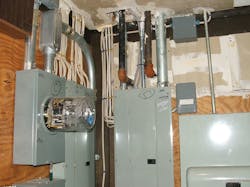How well do you know the Code? Think you can spot violations the original installer either ignored or couldn’t identify? Here’s your chance to moonlight as an electrical inspector and second-guess someone else’s work from the safety of your living room or office. Can you identify the specific Code violation(s) in this photo? Note: Submitted comments must include specific references from the 2014 NEC.
Hint: A pair of intruders
July Winner
Our lone winner this month was Marcus Beale, an electrician with Hanley Electrical in Kilmarnock, Va. He was able to correctly identify some of the Code violations found in this installation.
The sleeves used for these cables should be sealed with some type of approved fire-stopping material, as required by Sec. 300.21. Maintaining the fire-resistance rating of walls, floors, and ceilings is critical to minimizing the possible spread of smoke and fire throughout the building. Since these sleeves are not fire-stopped, they could act like chimneys and carry smoke to other parts of the building, essentially bypassing the firewalls.
Unfortunately, I have seen this phenomenon happen before when installers didn’t properly maintain the fire-resistance rating of the building components. Smoke, poisonous gases, and other products of combustion can find the smallest openings to pass through if not properly sealed. The huge pipes in this photo could allow massive amounts of smoke and gases to spread to other parts of the building. Building codes, product listings, and fire-resistance directories should be consulted to provide guidance on proper techniques for maintaining the integrity of fire-resistance ratings.
The lack of supports for these cables is certainly another cause for concern. Finally, it seems as though the “neat and workmanlike” requirements found in Sec. 110.12 may have been ignored by the installers as well.
About the Author

Russ LeBlanc
Owner
Russ started in the electrical trade as an apprentice in 1985. He worked his way up to become a Journeyman Electrician and then eventually became a Master Electrician and Licensed Construction Supervisor. In 1999 Russ become an Electrical Instructor for The Peterson School of Engineering in Massachusetts where he developed his passion for teaching, and quickly became Department Head of Electrical Instruction. Russ has taught thousands of apprentices, electricians, engineers, inspectors, and other electrical professionals during his career as an instructor. He continues to provide electrical professionals with Electrical Code seminars, Arc-Flash Awareness training seminars and educational material through his LeBlanc Consulting Services in North Reading, MA whose specialty is educating electricians. He has been an active member of the NFPA Electrical Section and has authored hundreds of National Electrical Code proposals and comments which have become Code rules to improve the safety for the electrical industry. Russ is also an IAEI certified Electrical Inspector.
Please visit www.russleblanc.net for more information.


